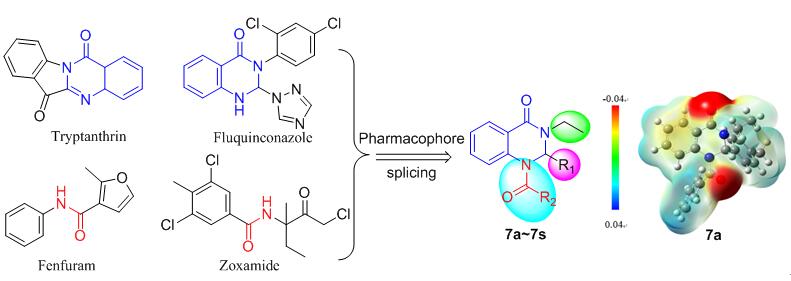| [1] |
Cui, Z. M.; Zhou, B. H.; Fu, C.; Chen, L.; Fu, J.; Cao, F. J.; Yang, X. J.; Zhou, L. J. Agric. Food Chem. 2020, 68, 15418.
doi: 10.1021/acs.jafc.0c06507
|
| [2] |
Kang, Z. S. Plant Prot. 2010, 36, 9. (in Chinese)
|
|
( 康振生, 植物保护, 2010, 36, 9.)
|
| [3] |
Guo, S.; He, F.; Song, B. W. Food Energy Secur. 2021, 10, e293.
|
| [4] |
Fan, Z.; Shi, J.; Luo, N.; Bao, X. Mol. Diversity 2019, 23, 615.
doi: 10.1007/s11030-018-9896-2
|
| [5] |
Liu, Z.; Cao, J.; Yan, X.; Cheng, W.; Wang, X.; Yang, R.; Guo, Y. Chem. Biodiversity 2020, 17, e2000763.
|
| [6] |
Gupta, T.; Rohilla, A.; Pathak, A.; Akhtar, M. J.; Haider, M. R.; Yar, M. S. Synth. Commun. 2018, 48, 1099.
doi: 10.1080/00397911.2018.1431282
|
| [7] |
Peng, J. W.; Yin, X. D.; Li, H.; Ma, K. Y.; Zhang, Z. J.; Zhou, R.; Wang, Y. L.; Hu, G. F.; Liu, Y. Q. J. Agric. Food Chem. 2021, 69, 4604-.
doi: 10.1021/acs.jafc.0c05475
|
| [8] |
Wang, J.; Battini, N.; Ansari, M. F.; Zhou, C. H. Chin. J. Chem. 2021, 39, 1093.
doi: 10.1002/cjoc.202000627
|
| [9] |
Liu, Y.; Chen, J.; Xie, D.; Song, B.; Hu, D. J. Agric. Food Chem. 2021, 69, 12135.
doi: 10.1021/acs.jafc.1c03171
|
| [10] |
Yang, X.; Wang, X.; Wu, M. Chin. J. Org. Chem. 2014, 34, 1015. (in Chinese)
doi: 10.6023/cjoc201311046
|
|
( 杨绪红, 王翔, 吴鸣虎, 有机化学, 2014, 34, 1015.)
|
| [11] |
Li, X. Q.; Gan, Y. Y.; Meng, J.; Li, W.; Chen, J.; Qi, Y. Y.; Tian, K.; Ouyang, G. P.; Wang, Z. C. J. Heterocycl. Chem. 2018, 55, 1382.
doi: 10.1002/jhet.3172
|
| [12] |
Shi, J.; Ding, M.; Luo, N.; Wan, S.; Li, P.; Li, J.; Bao, X. J. Agric. Food Chem. 2020, 68, 9613.
doi: 10.1021/acs.jafc.0c01365
|
| [13] |
Chalkha, M.; Moussaoui, A. E.; Hadda, T. B.; Berredjem, M.; Bouzina, A.; Almalki, F. A.; Saghrouchni, H.; Bakhouch, M.; Saadi, M.; Ammari, L. E.; Abdellatiif, M. H.; Yazidi, M. E. J. Mol. Struct. 2021, 1252, 131818.
doi: 10.1016/j.molstruc.2021.131818
|
| [14] |
Liu, X. H.; Qiao, L.; Zhai, Z. W.; Cai, P. P.; Cantrell, C. L.; Tan, C. X.; Weng, J. Q.; Han, L.; Wu, H. K. Pest Manage. Sci. 2019, 75, 2892.
doi: 10.1002/ps.5463
|
| [15] |
Zhang, R.; Guo, S.; Deng, P.; Wang, Y.; Dai, A.; Wu, J. J. Agric. Food Chem. 2021, 69, 10082.
doi: 10.1021/acs.jafc.1c03892
|
| [16] |
Noel, R.; Gupat, N.; Pons, V.; Goudet, A.; Garcia-Castillo, M. D.; Michau, A.; Martinez, J.; Buisson, D. A.; JoHannes, L.; Gillet, D.; Barbier, J.; Cintrat, J. C. J. Med. Chem. 2013, 56, 3404.
doi: 10.1021/jm4002346
|
| [17] |
Takács, A.; Fodor, A.; Németh, J.; Hell, Z. Synth. Commun. 2014, 44, 2269.
doi: 10.1080/00397911.2014.894525
|
| [18] |
Dabiria, M.; Salehi, P.; Mohammadi, Ali. A.; Baghbanzadeh, M.; Kozehgiry, G. J. Chem. Res. 2004, 2004, 570.
doi: 10.3184/0308234042563866
|
| [19] |
Krishnaji, T.; Murthy, V. N.; Raghunadh, A.; Rao, L. V. Russ. J. Org. Chem. 2020, 56, 1468.
doi: 10.1134/S1070428020080199
|
| [20] |
Heidary, M.; Khoobi, M.; Ghasemi, S.; Habibi, Z.; Faramarzi, M. Adv. Synth. Catal. 2014, 356, 1789.
doi: 10.1002/adsc.201400103
|
| [21] |
Mohammadpoor-Baltork, I.; Khosropour, A. R.; Moghadam, M.; Tangestaninejad, S.; Mirkhani, V.; Baghersad, S.; Mirjafari, A. C. R. Chim. 2011, 14, 944.
doi: 10.1016/j.crci.2011.05.003
|
| [22] |
Kemnitzer, W.; Sirisoma, N.; Jiang, S.; Kasibhatla, S.; Crogan-Grundy, C.; Tseng, B.; Drewe, J.; Cai, S. X. Bioorg. Med. Chem. Lett. 2010, 20, 1288.
doi: 10.1016/j.bmcl.2009.11.025
pmid: 20034792
|
| [23] |
Zuo, H. L.; Lei, S. M.; Zhang, R.; Li, Y. X.; Chen, W. Chem. J. Chin. Univ. 2021, 42, 2766 (In Chinese).
|
|
( 左怀龙, 雷思敏, 张锐, 李玉新, 陈伟, 高等学校化学学报, 2021, 42, 2766.)
|
| [24] |
Frisch, M. J.; Trucks, G. W.; Schlegel, H. B.; Scuseria, G. E.; Robb, M. A.; Cheeseman, J. R.; Scalmani, G.; Barone, V.; Petersson, G. A.; Nakatsuji, H.; Li, X.; Caricato, M.; Marenich, A.; Bloino, J.; Janesko, B. G.; Gomperts, R.; Mennucci, B.; Hratchian, H. P.; Ortiz, J. V.; Izmaylov, A. F.; Sonnenberg, J. L.; Williams-Young, D.; Ding, F.; Lipparini, F.; Egidi, F.; Goings, J.; Peng, B.; Petrone, A.; Henderson, T.; Ranasinghe, D.; Zakrzewski, V. G.; Gao, J.; Rega, N.; Zheng, G.; Liang, W.; Hada, M.; Ehara, M.; Toyota, K.; Fukuda, R.; Hasegawa, J.; Ishida, M.; Nakajima, T.; Honda, Y.; Kitao, O.; Nakai, H.; Vreven, T.; Throssell, K.; Montgomery, J. A.; Peralta, J. E.; Ogliaro, F.; Bearpark, M.; Heyd, J. J.; Brothers, E.; Kudin, K. N.; Staroverov, V. N.; Keith, T.; Kobayashi, R.; Normand, J.; Raghavachari, K.; Rendell, A.; Burant, J. C.; Iyengar, S. S.; Tomasi, J.; Cossi, M.; Millam, J. M.; Klene, M.; Adamo, C.; Cammi, R.; Ochterski, J. W.; Martin, R. L.; Morokuma, K.; Farkas, O.; Foresman, J. B.; Fox, D. J. Gaussian 09, Revision D.01, Gaussian, Inc., Wallingford CT, 2015.
|
| [25] |
Sun, C. X.; Zhang, S.; Qian, P.; Li, Y.; Ren, W. S.; Deng, H.; Jiang, L. Pest Manage. Sci. 2021, 77, 5529.
doi: 10.1002/ps.6593
|
 ), 雷思敏, 兰雨欣, 许豪键, 余坪槟, 张锐, 吴润, 陈阳
), 雷思敏, 兰雨欣, 许豪键, 余坪槟, 张锐, 吴润, 陈阳
 ), Simin Lei, Yuxin Lan, Haojian Xu, Pingbin Yu, Rui Zhang, Run Wu, Yang Chen
), Simin Lei, Yuxin Lan, Haojian Xu, Pingbin Yu, Rui Zhang, Run Wu, Yang Chen
